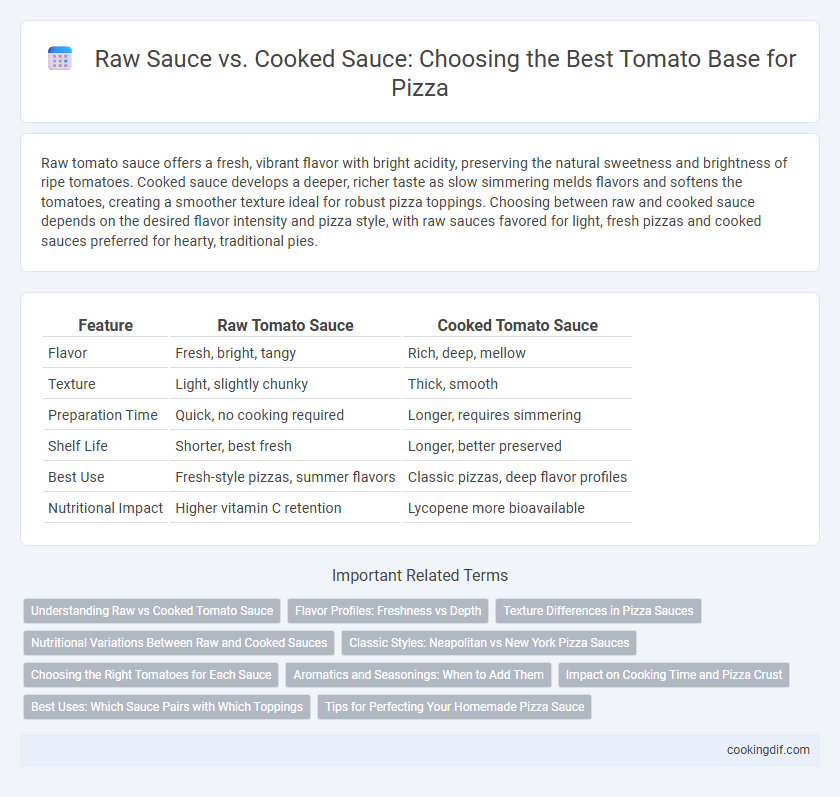Raw tomato sauce offers a fresh, vibrant flavor with bright acidity, preserving the natural sweetness and brightness of ripe tomatoes. Cooked sauce develops a deeper, richer taste as slow simmering melds flavors and softens the tomatoes, creating a smoother texture ideal for robust pizza toppings. Choosing between raw and cooked sauce depends on the desired flavor intensity and pizza style, with raw sauces favored for light, fresh pizzas and cooked sauces preferred for hearty, traditional pies.
Table of Comparison
| Feature | Raw Tomato Sauce | Cooked Tomato Sauce |
|---|---|---|
| Flavor | Fresh, bright, tangy | Rich, deep, mellow |
| Texture | Light, slightly chunky | Thick, smooth |
| Preparation Time | Quick, no cooking required | Longer, requires simmering |
| Shelf Life | Shorter, best fresh | Longer, better preserved |
| Best Use | Fresh-style pizzas, summer flavors | Classic pizzas, deep flavor profiles |
| Nutritional Impact | Higher vitamin C retention | Lycopene more bioavailable |
Understanding Raw vs Cooked Tomato Sauce
Raw tomato sauce offers a bright, fresh flavor and vibrant color, emphasizing the natural sweetness and acidity of ripe tomatoes. Cooked tomato sauce provides a deeper, richer taste through caramelization and prolonged simmering, resulting in a thicker texture and mellowed acidity. Understanding the differences helps pizza makers choose a sauce that complements their dough and toppings, balancing freshness and depth for optimal flavor.
Flavor Profiles: Freshness vs Depth
Raw tomato sauce offers a bright, vibrant flavor, highlighting the natural acidity and freshness of ripe tomatoes, perfect for a zestier pizza base. Cooked tomato sauce develops a deeper, richer taste through slow simmering, creating complex caramelization and umami that enhance overall pizza savoriness. Choosing between raw and cooked sauce depends on the desired flavor profile, balancing fresh brightness against hearty depth for your pizza.
Texture Differences in Pizza Sauces
Raw tomato sauce offers a fresh, vibrant texture with a chunkier consistency that preserves the natural juiciness of tomatoes, ideal for lighter, more rustic-style pizzas. Cooked tomato sauce delivers a smoother, thicker texture due to the slow simmering process, which intensifies flavors and reduces moisture for a richer, more cohesive base. The choice between raw and cooked sauce significantly impacts the overall mouthfeel and moisture balance in the finished pizza crust and toppings.
Nutritional Variations Between Raw and Cooked Sauces
Raw tomato sauce retains higher levels of vitamin C and antioxidants like lycopene, which are sensitive to heat and degrade during cooking. Cooking enhances the bioavailability of lycopene, increasing its absorption even though some heat-sensitive nutrients are diminished. Nutritional variations between raw and cooked tomato sauces impact vitamin content and antioxidant strength, influencing overall health benefits in pizza toppings.
Classic Styles: Neapolitan vs New York Pizza Sauces
Neapolitan pizza sauce features raw, crushed San Marzano tomatoes, offering a fresh, bright flavor with minimal seasoning that highlights the tomato's natural sweetness. New York-style pizza sauce is typically cooked, allowing the tomatoes to develop a deeper, richer taste with added garlic, onion, and herbs that create a robust, balanced profile. Both styles provide distinct foundational flavors, with Neapolitan sauces emphasizing freshness and simplicity, while New York sauces deliver complexity and warmth through cooking.
Choosing the Right Tomatoes for Each Sauce
Choosing the right tomatoes is crucial for raw versus cooked pizza sauces, as raw sauces benefit from ripe, juicy Roma or San Marzano tomatoes that provide a fresh, vibrant flavor with natural sweetness and acidity. For cooked sauces, plum tomatoes or canned San Marzano varieties are preferred due to their dense flesh and lower moisture content, which reduces cooking time and enhances sauce thickness. The tomato's balance of sugar and acidity directly impacts sauce consistency and taste, making tomato selection essential for achieving the desired pizza flavor profile.
Aromatics and Seasonings: When to Add Them
Aromatics and seasonings in pizza sauce influence flavor depth and intensity, with raw sauce benefiting from early incorporation to infuse freshness and brightness. Cooked sauce requires adding herbs and spices mid to late in the process to preserve their essential oils and prevent bitterness. Timing herbs like basil, oregano, and garlic is crucial for achieving a balanced tomato base that complements the pizza's overall profile.
Impact on Cooking Time and Pizza Crust
Raw tomato sauce preserves fresh acidity and moisture, which can extend pizza cooking time as the crust absorbs more liquid. Cooked tomato sauce reduces water content, allowing faster cooking and a crisper crust with less sogginess. Selecting between raw and cooked sauce directly influences oven time and the final texture of the pizza base.
Best Uses: Which Sauce Pairs with Which Toppings
Raw tomato sauce offers a vibrant, fresh flavor that pairs exceptionally well with light toppings such as fresh mozzarella, basil, and arugula, enhancing the natural taste of high-quality tomatoes. Cooked tomato sauce develops a richer, deeper flavor profile ideal for robust toppings like sausage, mushrooms, and caramelized onions, creating a balanced and hearty pizza experience. Choosing the right sauce depends on the desired flavor intensity and the topping combination, optimizing the overall taste harmony.
Tips for Perfecting Your Homemade Pizza Sauce
Using raw sauce preserves the fresh, vibrant flavor of tomatoes, making it ideal for light, bright pizza toppings, while cooked sauce offers a deeper, richer taste with enhanced caramelization and complexity. For a balanced homemade pizza sauce, blend high-quality canned San Marzano tomatoes, freshly minced garlic, and a pinch of salt, then either use it raw for a fresh burst or simmer gently to develop sweetness and thickness. Experimenting with herbs like basil and oregano in either preparation helps tailor the sauce to your preferred flavor profile, ensuring a perfect base for your pizza.
Raw sauce vs cooked sauce for tomato base Infographic

 cookingdif.com
cookingdif.com